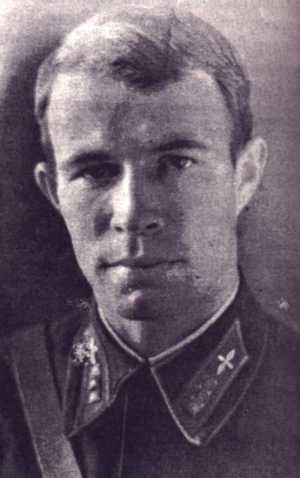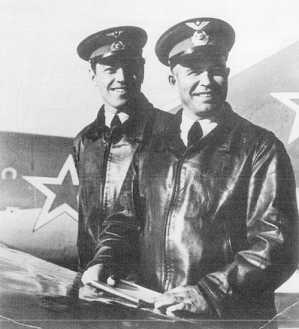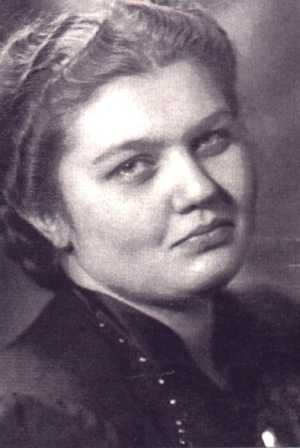Yevgeny Pepelyayev - top ace of the Korean War
Russian MiG-15 ace shot down 19 US planes
By Diego Zampini, Dec. 2004. Updated July 10, 2011.
The date was October 6 1951 and the Captain Gill Garrett was flying his 97th sortie in the F-86A Sabre # 49-1319 (336th FIS of 4th FIW), as leader’s wingman of a group of 4 Sabres. His squadron was doing a CAP over the “MiG Alley”, the area where the MiG-15s flown by the Communist pilots were more active. Garrett waited to end without trouble this one and the three remaining sorties left to complete the 100 of his tour, or even perhaps with some kills in his account.
As a matter of fact, he had already participated in 35 engagements and he also had seriously damaged a MiG few months earlier (on 19 August 1951), all without suffering a single scratch. But his luck was over that day, as Garrett himself explained:
Capt. Gill M. Garrett: “The two MiGs had led us straight into a trap. They had two buddies who now were cutting down on us from our flank at a time when we were at our lowest air speed. A MiG bore down on me and began firing with his 37 mm. and 23 mm. cannons. I could see that mean-looking red nose gun flash when my ship bucked, skidded around and head down. I had been hit – but good. A shell had slammed into my engine just aft of my right wing. The force of the blast had thrown the plane around and into a spin. One second I was in the middle of the fight the next I was on my way out with a GI insurance policy due to mature.”
Garrett had the bad luck to meet that day one of the best MiG-15 pilots never sent to Korea, who also was the commander of the 196th IAP (Istrevitenye Avia Polk = Fighter Aviation Regiment) of 324th IAD (Istrevitenye Avia Divizya , Fighter Aviation Division) of the VVS (Voyenno Vozdushnye Sily, Soviet Air Force): Polkovnik (Colonel) Yevgeny Georgievich Pepelyayev.
An Unpromising Start
Yevgeny Pepelyayev born on in Bodaybo, Irkutsk (Eastern Siberia), son of a railroad worker. Even when he learned and worked in his youth in the same profession than his father, like many other future aces he felt attraction for the aeronautics since his childhood, and when his elder brother Konstantin enlisted in the Soviet air force, he looked for job in Odessa as assistant in the aeroclubs of the city, with the intention to follow the steps of Konstantin later.
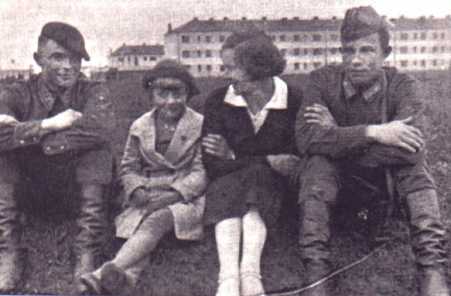
Pepelyayev's family (Odessa, 1937). From left to right: his elder brother Konstantin, his younger sister Ludmilla, his girlfriend Maya Konstantinovna Fayermann (later his wife) and Yevgeny.
He graduated in 1938 from the 8th Military Pilots School and was sent to serve in the regiments deployed in the Soviet Far East. When the German invasion to the USSR began in June 1941, he requested several times to be transfered to the battle front, and those requests were more frequent after his brother Konstantin was killed in action by German fighters. Those requests were always rejected, with the only exception of a short period when he played as instructor of the 162nd IAP (late 1943). And in this only instance, the bad weather reduce his battle chances to reconnaissance flights. In one of them, his Yak-7 was jumped by German planes and seriously damaged, but the skillful Yevgeny managed to return his base, where the Yakovlev could be repaired.
Those were hard times for Yevgeny: the death of his beloved brother and the fact that his military career seemed to be stuck made him to feel very frustrated. But Maya was always there to comfort him, to advice him and to support him. It was thanks to her strength that he didn't quit to the VVS.
Finally he could show his flying and command abilities at war: in 1945 he was the deputy commander of the 300th IAP, and his unit participated in the operations against Japan in Manchuria. Pepelyayev performed 20 combat sorties, finding no aerial opposition during them. Instead, a locomotive and a truck were destroyed in the ground by the heavy 37-mm cannon of Pepelyayev's Yak-9T before the end of the war on August 14 1945. However, the 300th IAP did not return to the USSR immediately, instead it was assigned surveillance over the deployment of the US troops in Korea. From its temporal base in Shenyang (Manchuria) Pepelyayev and his buddies accomplished their mission between November 9 1945 and March 1946, when the unit was sent back to the Soviet Union.
Always hungry of new knowledge and encouraged by Maya, Yevgeny applied for a technical and command course in the VVS Academy. It was not easy, at that time it was hard for an officer serving in the Soviet Far East to be taken into account for a course of technical improvement, but his persistence succeeded. Pepelyayev began the course in the autumn of 1946, and he approved it with honors in 1947. Then, while waiting for his new assignment, he rewarded the 10 years of patience and support of Maya, and made her his wife.
In December 1947 he became the XO of the unit which would make him famous: the 196th IAP of the 324th IAD. This unit was among the first ones in the VVS to enter the jet age when was equipped with the newest La-15, and the regiment made an acrobatic show during the parade of the May 1st 1948 in Moskow. In July 1949 the regiment began to receive a new ride: the MiG-15. And soon Yevgeny mastered the flight on it.
Even when his flight habilities and command capacities didn’t remain unnoticed certainly nothing seemed to indicate that he would become one of the top aces of the typical conficts caused by the “Cold War”. But then in June 25 1950 the Korean War began, and everything changed.
USSR enters Korean War
When in October 1950 the Colonel Pepelyayev recieved the command of the 196th IAP, the War of Korea was in its climax, with the UN troops and air forces (led by USA) entering in North Korea after defeating the initially succesful North Korean invasion to South Korea. Both Joseph Stalin and Mao-Tse-Tung decided that they would not see how a Communist allie (Kim Il Sung) was defeated without move a finger. Secretly the USSR sent several air regiments equipped with the new MiG-15s to the Chinese base of Antung (in Manchuria) with the mission to support the Chinese counter-strike. In a short period of time the Soviet fighters transformed the southern shore of the Yalu river in the most dangerous area for the UN aviation, zone that received the nickname of “MiG Alley”.
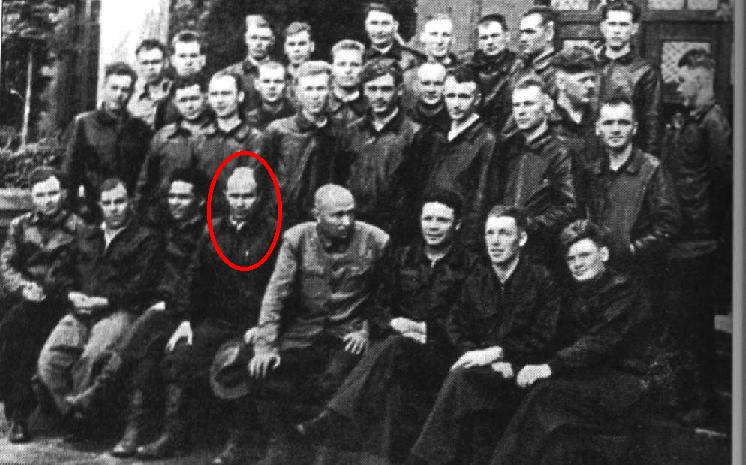
All the pilots of the 196th IAP/324th IAD in Antung, early 1951, prior to the beginning of the war operations. Surrounded by a red elipse, Yevgeny Pepelyayev.
Anyway, the arrival of the fighters F-86 Sabre of the 4th Wing of the USAF in December 1950 turned the tables in favour of the UN again. It was decided to create the 64th IAK (Fighter Corp) with two fighter regiments and to assign them the best available pilots. The chosen units were the 176th GvIAP and 196th IAP (Pepelyayev’s unit) of the 324th Division and the entire division was put under the command of the best possible man: Colonel Ivan Kozhedub, three times awarded with he Golden Star of the Heroe of the Soviet Union (the highest Russian military award) and Top Scoring Soviet Ace of the WWII with 62 victories against the German Luftwaffe.
Pepelyayev arrives at Antung
The 196th Regiment arrived to Manchuria in January 1951, and it remained in second-line airfields until complete the training of the pilots and their familiarization with the temperamental MiG-15 with Kimov RD-45 engine, and then was re-deployed to Antung. On April 1 both regiments were finally commited to combat, but their results weren’t good initially: on April 3 three MiGs of the 176th GvIAP were shot down by the American Sabre pilots (one of them by James Jabara ) and only one F-86A was downed by Kapetan (Captain) Ivan Yablokov - the one flown by Ronald Shirlaw (POW). The reason was simple: in an attempt to keep in secret the Soviet injerence, the Soviet pilots were ordered of speak only Korean or Chinese language in the radio. It caused a lot of complains from Pepelyayev and Col. A. S. Koshel, CO of the 176th GvIAP. As Pepelyayev himself explained:
Col. Yevgeny G. Pepelyayev: “It was impossible psychologically in the heat of battle to use a foreign language you hardly knew. So after a week or two we just decided to ignore the order. The top brass started complaining, so I told them: ‘Go and fight yourselves!’.”
Col. Kozhedub supported his subordinates in front of the commander of 64th IAK, Lt.Gral Ivan V. Belov, and due to Kozhedub was one of the Stalin’s “favourite sons”, the High Command of the VVS finally gave up and allowed that the pilots speak Russian in combat. That caused an immediate raise in battle efficiency: next day April 4 the MiG-15 pilot Starshii Leitenant (1st Lt.) Fiodor A. Shebanov scored the first victory of the 196th IAP when bagged one F-86A (not admitted by USAF but confirmed by the gun-camera footage and the fact that a Soviet ground party led by Major V. P. Zhuchenko found the Sabre's wreckage in the ground), on 7 April the MiG drivers of the 176th GvIAP shot down the F-80C of Jack Thompson (downed by Boris Obratsov) and the B-29A BuNo 44-86268 (by Ivan Suchkov), and finally on April 10 again Fiodor Shebanov shot-up the F-86A BuNo 49-1093 and his buddy the WW2 ace Kapetan Aleksandr Vasiko bagged the F-80C of Douglas Matheson (KIA).
A
33-year
old Yevgeny
Pepelyayev in 1951,
just after returning of a combat sortie.
Such improvement in the combat performance reach its peak on April 12 1951. That day 44 MiG-15s of the 176th GvIAP and 196th IAP intercepted an American formation of 48 B-29s of the 19th, 98th and 307th BW (Bombing Wings) escorted by 34 F-84s and 18 F-86s, plus 24 F-80s to perform flak suppression, when they tried to attack the bridges across the Yalu. In the ensuing battle 10 B-29As and three F-80Cs were shot down or damaged beyond repair, all that against the loss of a single MiG due to a Sabre (despite the American claims of 4 MiGs downed by the F-86 Sabres and 6 more by the B-29's gunners). It is fair to be told, the Soviet pilots also overclaimed, because they asserted to shot down 12 B-29s, four F-80s and two F-86s. During this battle Pepelyayev's unit scored the shootdown of two B-29s - downed by Kapetan Viktor A. Nazarkin and Starshii Leitenant Fiodor A. Shebanov respectively. Sadly the 196th was also which suffered the single Soviet loss, when the MiG of Kapetan Yakovlev was badly shot-up by James Jabara and written off after landing, but Yakovlev was not wounded, and that was a relief.
First victories
May 20 1951 meant the end of three weeks where both sides were relatively quiet. That day a force of 36 MiGs fought with 28 Sabres, and during that combat both sides claimed more victories than the ones they actually scored (USAF claimed three MiG kills and the VVS to shot down four F-86s). The truth is that while the Americans only shot down one MiG, the Russians only damaged beyond repair three Sabres. In first place the lethal F-86 Sabre pilot Captain James Jabara shot down one of the Pepelyayev’s men, Kapetan Viktor Nazarkin, and in retaliation the commander of the 196th IAP, flying the MiG-15bis Fagot Nº 0715368, shot down one F-86; as indicates the after-battle report presented by Pepelyayev:
Col. Yevgeny G. Pepelyayev: "...on 20 May 1951, during the period of 15:08-15:58 hours, during an air battle with a group of F-86 Sabres I fired at an F-86 at a range of 500-600 meters. At the time of my firing, I noticed shell strikes along the enemy's right wing, after which the aircraft went from a bank to the left into a right turn."
It
must be noted here that he do not claim any shoot-down directly; he do
not say “I
shot down an F-86” but he simply describe what really happened, and
such
style is typical in all his reports. As a matter of fact, the burst
fired by
Pepelyayev did more than to hit the right wing of that Sabre, it
actually struck
the ammunition bay of the F-86A BuNo 49-1080 flown by 1st Lt. Milton
Nelson (335th
FIS), causing that the 0,50" M23 ammo blew up, destroying the
hydraulic lines of Nelson's aircraft. The skillful Nelson (who wrongly
had
claimed a MiG kill few minutes earlier and would shot down 2 MiGs fully
confirmed by the Russian loss records) managed to bring his crippled
Sabre back
to Kimpo, but then it was written off. Nelson never saw Pepelyayev, and
he
wrongly assumed that the troublesome M23 ammo had blown away alone.
Without
knowing it, Nelson became the first out of the 19 victories that Polkovnik
Yevgeny Pepelyaeyev would be credited with.

Profile drawing of the MiG-15bis Nº 0715368 "768" flown by Polkovnik Yevgeny Pepelyayev on May 20 1951, when he shot up the F-86A BuNo 49-1080 of 1st Lt. Milton Nelson (335th FIS), his first aerial victory. The "768" was a temporary assignment until his definitive aircraft the MiG-15bis "325" was ready. - Drawing by Yury Tepsurkayev.
That was a good day for the 196th IAP: despite the loss of Nazarkin's MiG, the Russian flier bailed out safe and sound, and in return three Sabres were damaged beyond repair; besides Pepelyayev shoting up the F-86A of Milton Nelson, Majora (Major) Nikolay K. Kirisov so did with the F-86A BuNo 49-1313 of Captain Max Weill, and Starshii Leitenant Vladimir I. Alfeyev damaged beyond repair the F-86A BuNo 49-1318 of James Jabara.
On July 11 at 9:35 hs 26 MiG-15s of the 196th IAP led by Pepelyayev himself joined to a battle between the 176th GvIAP and the 335th and 336th FIS, and their presence was soon noticed: Followed by his wingman Starshii Leitenant Ivan V. Larionov, Yevgeni G. Pepelyayev lined up his MiG-15bis Nº 1315325 behind two Sabres and opened fire with his terrible NR-37 cannon at a range of 500-600 mts against the F-86 wingman. Let's read how the Russian "Honcho" recalled that engagement:
Col. Yevgeny G. Pepelyayev: "In this same combat I pursued a F-86, and there was a moment when this Sabre slowed down his maneuver, then I performed an slight turn right bellow him at his 6 o'clock, and I opened up. Pieces of debris flew away of the Sabre from the right wing. The aircraft violently spun to the right and downwards. One of my pilots screamed:
-There it goes!
I didn't follow that Sabre - the combat still went on. I remember I thought with a lot of satisfaction, that later I would show this guncamera footage to my pilots - so they would learn how to shoot."
His victim was the F-86A BuNo.49-1297 (336th FIS), flown by a pilot surnamed Reeves, who managed to bring his crippled Sabre back to Suwon, but once there crashed on landing. Fortunately Reeves was not injured at all, but his F-86A was written off two days later. The USAF officially reported the loss as a “landing accident”.
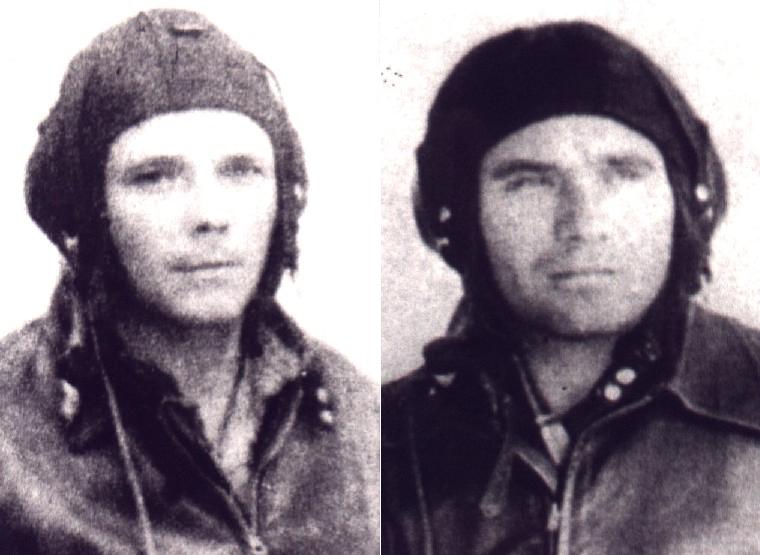
Aleksandr D. Ryzhkov (left) and Ivan V. Larionov (right) were the wingmen of Yevgeny Pepelyayev during the Korean War. Larionov was shot down and killed by the Sabre pilot Milton Nelson (335th FIS) on July 11 1951. Aleksandr Ryzhkov was credited with 4 victories against American aircraft, 2 of them match with admitted US losses (a F9F-2B of VMF-311 on October 3 1951, and the F-86A of David B. Freeland on November 8 1951). Ryzhkov was killed in action by Winton Marshall on December 5 1951.
But then tragedy struck: Pepelyayev and Larionov should be covered by the zveno of Kapetan Viktor Nazarkin, however because of reasons not clearly established yet, Nazarkin’s group stayed in the high without participating in the battle, and a flight of F-86A Sabres took advantage of that, jumping the MiGs of Pepelyayev and Larionov.
Col. Yevgeny G. Pepelyayev: “ I assumed that my wingman and the flight of Kapetan Nazarkin were covering me. But Nazarkin's zveno couldn't do it. As he explained me later, he was blinded by the sun glare and lost track of me. The Americans used that, attacked my wingman Larionov and shot him down. We couldn't even bury him - he fell in Yellow Sea. Then the US fighters opened fire on me. A second pair of enemy aircraft comes in and Nazarkin is still away. I understood I was on my own and put my plane in a spin hoping to get in the clouds below. I was going down and one Sabre was following me firing all the time, but he wasn't good enough and couldn't hit me. I entered in the clouds, leveled on just over the water and headed back to my airfield.”
Without knowing it, 1st Lt. Milton Nelson took revenge of his defeat 52 days before, when he was downed by Pepelyayev. In return Nelson shot down and killed Ivan Larionov. Then 1st Lt. Alonzo G. Walter jumped Pepelyayev’s MiG, claimed to damage it and saw it going down apparently in an uncontrolled spin. However, as we read in Pepelyayev’s account, it was actually a trick: Pepelyayev and most of pilots with thousands of hours flying the MiG-15 knew how to enter in a controlled spin but later regain control of their aircraft. And this time the trick worked. When Pepelyayev landed in Antung, he immediately asked Nazarkin why he didn’t cover him, and Nazarkin told him that because of the sun glare. Pepelyayev was not totally convinced, and he supposed that Nazarkin could have been affected by the experience of being downed and nearly killed by James Jabara on May 20. That might have caused that Nazarkin became reluctant to be involved in a fight against the F-86s again. Despite Pepelyayev appreciated the combat skills and aggressiveness previously demonstrated by Kapetan Nazarkin (he had been credited with three victories) and understood how shocking was the experience of being shot down, he concluded that in such present situation Nazarkin was a danger for his comrades, so Pepelyayev asked that Nazarkin returned to the USSR because of medical reasons.
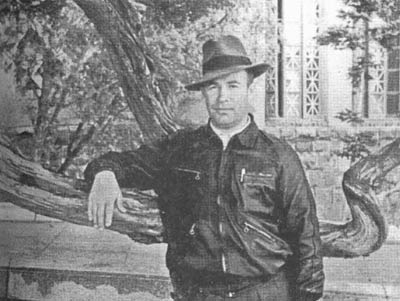
Pepelyayev in Antung, August 1951.
Few days later, on July 21, 10 MiG-15s of the 196th IAP led by Pepelyayev intercepted what they wrongly identified as a formation of "F-94s" (actually F9F-2Bs of the USMC's squadron VMF-311), and they devastated it: Pepelyayev claimed to shot down with his MiG-15 two of the enemy aircraft, and his deputies claimed to destroy five more of those "F-94s". The Chinese search teams confirmed part of these claims, because they found four wreckages. In the case of Pepelyayev’s claims, the Chinese could confirm one of them - they found the remains in one of the two set of coordinates indicated by him, reported a serial number in the wreckage (“109I405116”) and also found the death body of the pilot in the crash site. They also confirmed the sole victory claimed by Kapetan Boris S. Abakumov (the US pilot, Lt. Richard W. Bell, was captured) and both the two victories claimed by Starshii Leitenant Andrey I. Pupko.
The Sabre’s Hunter
But the most important MiG-15 victory of this period happened on October 6 1951, when Colonel Pepelyayev (flying the MiG-15bis Fagot Nº 1315325 again), during a battle among 10 MiGs belonging to his regiment and 16 Sabres of 4th FIW at 8,000 meters (about 24,000 feet), he downed 2 F-86s with 37 mm ammunition. In first place he organized the engagement and later himself performed an attack against the leader of the heading pair of Sabres, firing against him at 550 meters (yards), without confirm the results of the attack, due to the second pair of Sabres also attacked both MiGs -Pepelyayev's and the one of his new wingman, Aleksandr Ryzhkov- almost in a head-on attack. According to Pepelyayev himself:Col. Yevgeny G. Pepelyayev: "I remember this battle as if it happened yesterday. Their leader opened fire on my aircraft and ripped off a piece of the air intake...
I remembered a maneuver developed by me and my friends, when we were trying to develop new tactics. During head-to-head attacks, when both aircraft are trying to get on each other's tail, one of the maneuvers was to indicate a ‘boevoj razvorot’ [combat turn in Russian - Note of Vladislav Arkhipov] to one side, but then to make a sharp turn to the other side and follow the opponent. When the enemy aircraft would exit from the combat turn, I would end up on its tail. That's what happened that time. When I passed the Sabres on the head-to-head course, they initiated a right turn while rapidly gaining altitude. I , on the other hand, continued to fly level for a while, and then begun turning to the right, towards the Sabres. When I achieved a turning angle of between 40-50 degrees, I initiated a sharp left turn and ended up behind the lead Sabre slightly above it and to the right.
It was almost directly in front of me, just over 100 meters [300 feet] away. I pushed the stick, trying to align with the Sabre. However, the targeting indicator would always be above the Sabre, while at the same time negative g would try to pull me out of the cockpit. Then I rolled upside down so the g-force would press me into the seat; it's more convenient to aim that way. As soon as I rolled, the Sabre did the same thing, but by then I already got the targeting indicator over him, and I opened fire from a distance of 130 meters [364 feet]. A 37 mm shell hit him directly behind the cockpit. There was an explosion and the Sabre started to losing altitude. I did not follow him: after such a hit there was no reason to pursue him."


These stills were captured by the gun camera of the 37 mm cannon belonging to the plane MiG-15bis Nº 1315325 flown by Col. Yevgeny Georgievich Pepelyaev on October 6 1951. In them appears the F-86A BuNo 49-1319 flew by Captain Gill M. Garrett perfectly placed in the fire line. The first photograph was taken at 130 meters (364 feet), and the second one at 122 meters (342 feet).
The Sabre's pilot, Captain Gill M. Garrett, used all his abilities to land upon his damaged plane in the Sokhoson Bay (East China Sea), and the American pilot was rescued by a SA-16 Albatross seaplane. It must be noted that the Sabre leader of the one hit by Pepelyaev, gallantry tried to provide cover to Garrett during the time after being hit until it landed in the sea shore; but it was seen by a group of MiG-15s of the 176th GvIAP, leading by the unit's deputy commander, Kapetan Konstanin Y. Sheberstov. Sheberstov chased that Sabre (the F-86E BuNo 50-671), caught him by surprise and shot up its hydraulic lines so badly that the unknown pilot barely managed to reach the UN lines and then was forced to eject. Few hours later, Pepelyayev blasted another Sabre out of the sky, the F-86A BuNo 49-1267 (334th FIS), his second kill of the day (according to USAF official records, this Sabre was lost because of an "engine failure").
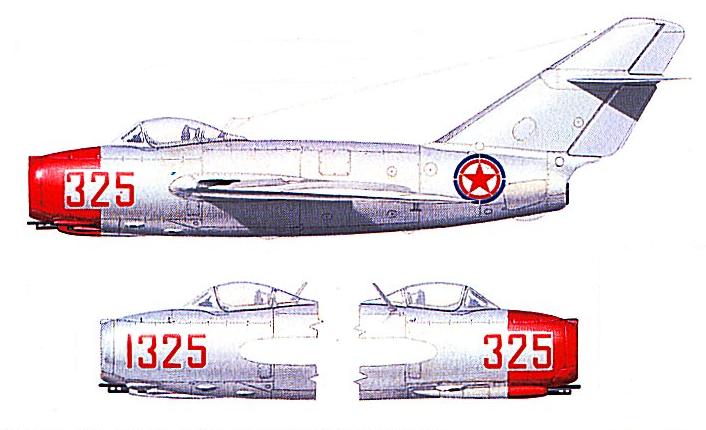
Profile Drawing of the MiG-15bis Nº 1315325 flown by Yevgeny G. Pepelyayev (196th IAP, 324th IAD) on October 6 1951 when he shot down the F-86A BuNo 49-1319 of Gill M. Garrett (336th FIS) and the F-86A BuNo 49-1267 (334th FIS). With this aircraft Pepelyayev scored 17 out of his 19 victories.
The first Sabre downed by Pepelyayev (Garrett’s) was left almost intact on mud flats over the sea shore. It was gold for the USSR; finally a chance to get a look to the hottest USAF fighter jet, and the Soviet technicians took the chance: a special team leaded by the Engineer Kazankin achieved to rescue the damaged plane, put it on a truck and sent it to USSR (after a dangerous travel where the American B-26s attempted to destroy the remains of the Sabre). 
This picture shows the aspect of the F-86A Sabre BuNo 49-1319 when it was rescued from the shore of the Yellow Sea after being shot down by Yevgeny Pepelyayev on October 6 1951. This plane was sent to the Soviet Union.
Pepelyayev still scored one more victory that month: on October 16 both he and his wingman Aleksandr Ryzhkov caught by surprise a pair of Sabres of the 336th FIS (Douglas Evans and Nicholas Kotek) and the American fliers barely avoided being swept of the sky by the Russian "Honcho".
1st. Lt. Douglas K. Evans: "The squadron divided down into flights for better maneuverability and Maj. Creighton and I, as Red One and Three, took our elements down on a lone MiG we spotted and then lost below the rim of the horizon, so we pulled back up to regain our altitude. Nick Kotok (Red Four) and I saw two planes going around below us and I called Creighton and Pat Green (Red Two) to make a 180. When they did they both yelled at us, 'Break left! There's a MiG right on you!'
Pat later told me that this MiG was right on our tails and evidently out for blood, as he fired damn near point blank just as we broke and must have snapped upright trying to follow our tight turn, then just hauled it straight up and out. Pat said it sure was a close thing, but ignorance is bliss and I had replied over the radio, 'I don't see a thing, no sweat.' "
As a matter of fact, Pepelyayev had opened fire before Kotek was able to break -the guncamera pics show that Pepelyayev was at only 80-100 meters (240-300 feet)- and one 23 mm shell hit Kotek's F-86A (BuNo 49-1147) in the fuel tank. Initially that was not noticed by the US pilots, but during the return Nick Kotek realised he was running out of fuel and was forced to bail out before to reach his base. In good faith Kotek and USAF believed that the loss have been caused by "fuel starvation". The truth was that the "Sabre Hunter" had piled up one more F-86 to his scoreboard.
Yevgeny was credited with another Sabre kill on October 28, but the truth is that no F-86 was lost that day, so it is an overclaim in good faith (one of Pepelyaev's few ones). Anyway, if October was good for his hunter's instinct, November would be even better.
A Red Predator over the "MiG Alley"
Since November 1951 untill January 1952 both sides tried to achieve the air superiority over the Yalu, or at least tried to deny it to the enemy, and in consequence the intensity of the aerial combats reached peaks not seen before. It was a good time for the aggressive fighter pilots both Soviets and Americans, and Pepelyayev was among them. November 8 1951 was a day particularly succesful for him, because he piled up two American aircraft into his scoreboard: at 12:10 Pepelyayev led 20 MiG-15s of his unit to perform a CAP over the "MiG Alley", and about 30 minutes later at 7,000 meters (21,000 feet) over Pkhenvon he spotted four F-86s, apparently unaware of their presence. Without hesitation Pepelyayev jumped the American element wingman and opened fire with the 3 cannons of his MiG-15bis at 150-200 meters (450-600 feet):
Col. Yevgeny G. Pepelyayev: “ I hit this Sabre so hard that it disintegrated. The pieces of its right wing ripped away, and its vertical stabilizer also tore apart. The Sabre began to spin and plunged to the ground. One of my pilots screamed: 'Cool!' and I replied: 'Watch up, bunch of idiots, and take care of not being surprised and shot down by the enemy!'
I get down of the cockpit thinking about to show the gun-camera footage to the whole regiment with educational purposes; but the footage only showed an usine and a chimney instead of showing the Sabre... . It happened that I loaned my aircraft to another pilot because no other MiG was available. This guy fell asleep in the cockpit during an alert wait and he accidentally laid on the commutator. The result was that it consumed the whole film that I should use. But anyway I got the full credit for this victory: the aircraft crashed and the debris was recovered from the terrain a little bit later. The American pilot did not eject."
Pepelyayev's victim was the F-86A BuNo 49-1338 of Charles W. Pratt (334th FIS), who perished. As a matter of fact, a second Sabre fell in that engagement: Yevgeny jumped another F-86A -flown by David B. Freeland, of the 336th FIS- and despite he damaged it, he ran out of ammo before to finish him off, so he called his wingman Starshii Leitenant Aleksandr Dmitryevich Ryzhkov, who had no problems to give Freeland the coup d'grace and force him to bail out - Pepelyayev witnessed the ejection. After returning to Antung Pepelyayev was offered a 'group' kill shared with his wingman, but he refused and gave to "Sasha" Ryzhkov the whole credit for the aerial victory against Freeland's F-86 (BuNo 48-259). But there was a prize to pay for such successes: during that combat the future Sabre ace William T. Whisner scored his first victory in Korea when he shot down the MiG of one of Pepelyayev's men, Starshii Leitenant Aleksey F. Trabin, who was killed in action.
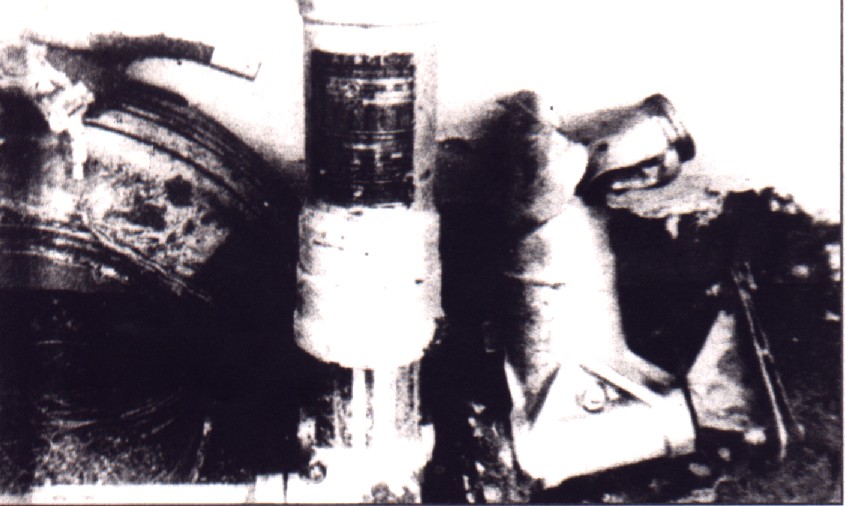
Photo taken by the Soviets of the remains of the F-86A BuNo 49-1338 flown by 1st Lt. Charles W. Pratt (334th FIS) on November 8 1951, when he was shot down and killed by Yevgeny Pepelyayev.
Few hours later (15:05 hs) Pepelyayev again led another group of six MiG-15s of the 196th IAP when intercepted a RF-80A of the 15th TRS escorted by a group of F-80Cs and F-84Es, and despite such escort, Pepelyayev did not sweat at all to shot down this RF-80A (the pilot Dennis W. Hill ejected safe and sound, and was rescued - he was so unaware of the presence of Pepelyayev, that he thought he had been hit by AAA), and the arrival of more MiG-15 of the 176th GvIAP disbanded the escorts. The flier of one of these MiGs, Konstantin Sheberstov, bagged one of the escorting Shooting Stars, killing the pilot (Jerome A. Volk).
After a rest of two weeks, in only 3 days in late November he bagged four American aircraft: On November 27 he had no problems blasting out of the sky the F-80C flown by Bernard K. Seitzinger (7th FBS of 49th FBW, KIA) and the next day, November 28 1951, destroyed 2 F-86s in a matter of minutes; flying his MiG-15bis Fagot Nº 1315325, Yevgeny Pepelyayev badly shot-up the F-86A BuNo 49-1166 [USAF admitts the loss, but credits it to a "collison with an object"] and then heard the anguished cries for help of one of his men, Starshii Leitenant Alfey Dostoievsky, who was under attack of a very aggressive Sabre. Despite he ran to help Dostoievsky at full throttle, Pepelyayev could not do anything to prevent that the F-86 shot down his subordinate, who bailed out and landed safe and sound. But then Yevgeny avenged Dostoievsky putting that Sabre in his gunsight and squeezing the trigger; two bursts of the lethal 37 and 23 mm cannons at only 180-140 meters (540-420 feet) were enough to send the F-86E BuNo 50-673 downwards in flames and to force its pilot, 1st Lt. Dayton Ragland, to eject to his captivity (Besides shooting down Dostoievsky that day, Ragland and Kenneth Chandler had performed an audacious strike against North Korean airbase of Uiju 10 days earlier, on November 18, destroying four MiGs in the ground).


One of the victories achieved by the MiG-15s during the last months of 1951 was the one that can be seen in these stills, scored on November 28 1951 by Yevgeny Pepelyaev. It was the F-86E BuNo 50-673 flown by 1st Lt. Dayton W. Ragland (336th FIS), who bailed out and became POW.
Pepelyayev would score his kill #14 the next day (November 29 1951), when he riddled the F-86A BuNo 48-301 of the 334th FIS at 13:38 hs over Syukusen. Somehow the unknown but indeed skillful pilot of that Sabre managed to bring his crippled aircraft back to Kimpo, but the aircraft was so damaged that was written off as scrap iron on December 9.
This victorious streak reach its peak on December 1st 1951 during a combat sortie occurred between 15:00 and 15:55 hs, when the 196th IAP intercepted the Shooting Stars of the 35th FBS which were strafing the marshalling yards of the North Korean capital, Pyongyang. In a blink of an eye, Pepelyayev (flying this time the MiG-15bis Nº 1815399 because his usual ride the MiG "325" was under maintenance) forced 1st Lt. Thomas T. Mounts to bail out of his F-80C BuNo 49-855 in flames, and so did his comrade V. G. Muravyov with the F-80C of William Womack (in this case the American flier was not so lucky, he perished). That was a great day for the Russian MiG-15 pilots, because an hour later the 176th GvIAP ambushed the Australian Meteors of the No.77 Sqdn, and shot down three of them. So, the Russians scored five victories and suffered no losses.
Pepelyayev scored most of his victories while flying the MiG-15bis "325", but achieved his first kill with the MiG-15bis "768", and his 15th one (the F-80C flown by Thomas T. Mounts) on December 1 1951 in the cockpit of the MiG-15bis Nº 1815399 "899". - Drawing by Yury Tepsurkayev.
Pepelyayev should wait more than a month (and a new year) to shows his lethal skills again. On January 6 was credited with an F-86 kill, and as a matter of fact USAF admitts the loss of a Sabre by MiGs that day, but so far it seems that this F-86 was shot down by his countryman Nikolai Sutyagin. The air combats on January 7 1952 were a fully different matter: at 8:40 hs in the morning Pepelyayev scrambled of Antung and led 18 MiG-15s of his regiment to engage a group of enemy aircraft. Nine minutes later over Sinuiju the 196th IAP entered in a melée with the Sabres of the 25th FIS/51st FIW, and Pepelyayev set on fire the F-86E BuNo 50-651 forcing the American pilot Charles E. Stahl to eject (Stahl was subsquently captured by Chinese troops).
Yevgeny claimed to shot down another F-86 next day, but his victim (F-86E BuNo 50-679) was only damaged, could be repaired and returned to combat - only to be destroyed on October 11 1952 by the MiG-15 ace Kapetan Nikolay M. Zameskin while flown by John E. Fagan.
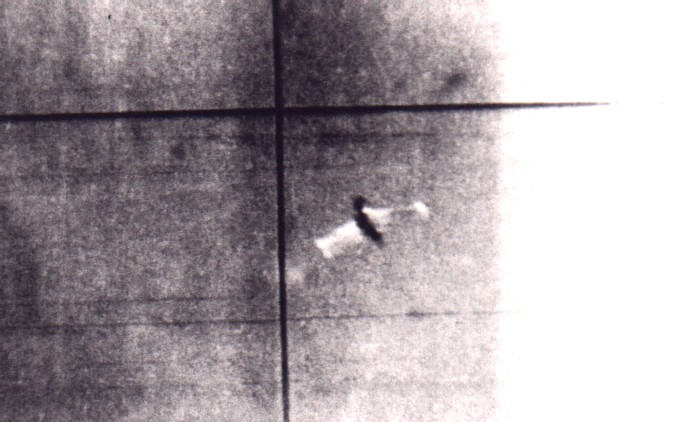
This picture was taken on January 7 1952 by the guncamera mounted in the MiG-15bis Nº 1315325 of Yevgeny G. Pepelyayev, and shows the last moments of the F-86E BuNo 50-651 of the 25th FIS. The US flier, Charles Eugene Stahl, ejected and became POW.
Few days later, on January 11, Pepelyayev and two other pilots of his regiment (Captains V. G. Murayov and Boris Bokach) claimed to score F-86 kills, but so far it seems that these are overclaims in good faith, and that the only Sabre loss of the day (F-86E BuNo 50-612, Thiel M. Reeves, KIA) was actually scored by another Russian MiG-15 ace: Nikolai Sutyagin. Few days later, on January 15, Pepelyayev flew his last combat sortie in Korea, and two weeks later his unit was sent back to the Soviet Union.
Pepelyayev's personal combat record was impressive, to say the least: he flew 109 combat sorties, he participated in 38 aerial combats, and was credited with 19 aerial victories against American aircraft (14 F-86s, two F-84s, one F-80 and two "F-94s"). And we must remember that such achievement (and the ones of his fellow pilots) were accomplished by pilots that wore no g-suits at all, as the American fliers did.
Hero of the Soviet Union
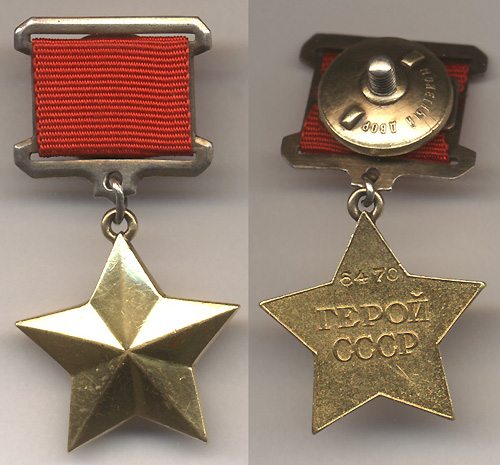
After such formdable combat career, it wasn’t a surprise when, on April 22 1952, Colonel Yevgeni Pepelyayev was awarded with the Zolotaya Zvezda - myedal Geroya Sovietskogo Sojuza (The "Golden Star" - the medal of Hero of the Soviet Union), the highest Soviet military decoration. A particular characteristic of the ceremony was that Pepelyayev wore civilian clothes, and in the speech there was no mention of the actions why he deserved the award. The need to keep the secret caused that such story repeated with the 22 Soviets pilot who were awarded during the Korean War.
His impressive scoreboard of 19 victories was only surpassed by another Soviet pilot who fought in the same period: Captain Nikolai V. Sutyagin (17th IAP, 303rd IAD) with 21 claims (13 of them confirmed by USAF). All the 19 victories of Yevgeny Pepelyayev are summarized in the Table # 1:
Table # 1: Claims and confirmed victories of Yevgeni G. Pepelyayev
| Date | Unit | Aircraft | Weapon | Victim | Status/Name | Unit/Service |
| 20-May-1951 | 196 IAP, 324 IAD | MiG-15bis | 23/37mm | F-86A | Milton Nelson (*) | 335 FIS, USAF |
| 11-Jul-1951 | 196 IAP, 324 IAD | MiG-15bis | 23/37mm | F-86A | BuNo 49-1297 (*) | 336 FIS, USAF |
| 21-Jul-1951 | 196 IAP, 324 IAD | MiG-15bis | 23/37mm | F9F-2B | BuNo 109I405116 | VMF-311, USMC |
| 21-Jul-1951 | 196 IAP, 324 IAD | MiG-15bis | 23/37mm | F9F | ----- | USMC (**) |
| 6-Oct-1951 | 196 IAP, 324 IAD | MiG-15bis | 23/37mm | F-86A | Gill M. Garrett | 336 FIS, USAF |
| 6-Oct-1951 | 196 IAP, 324 IAD | MiG-15bis | 23/37mm | F-86A | BuNo 49-1267 (*) | 334 FIS, USAF |
| 16-Oct-1951 | 196 IAP, 324 IAD | MiG-15bis | 23/37mm | F-86A | Nicholas Kotek (*) | 336 FIS, USAF |
| 28-Oct-1951 | 196 IAP, 324 IAD | MiG-15bis | 23/37mm | F-86 | ----- | USAF(**) |
| 8-Nov-1951 | 196 IAP, 324 IAD | MiG-15bis | 23/37mm | F-86A | Charles W. Pratt - KIA | 334 FIS, USAF |
| 8-Nov-1951 | 196 IAP, 324 IAD | MiG-15bis | 23/37mm | RF-80A | Dennis W. Hill (*) | 15 TRS, USAF |
| 27-Nov-1951 | 196 IAP, 324 IAD | MiG-15bis | 23/37mm | F-84E | B. Seitzinger (*) - KIA | 7 FBS, USAF |
| 28-Nov-1951 | 196 IAP, 324 IAD | MiG-15bis | 23/37mm | F-86A | BuNo 49-1166 (*) | 4 FIW, USAF |
| 28-Nov-1951 | 196 IAP, 324 IAD | MiG-15bis | 23/37mm | F-86E | Dayton Ragland - POW | 336 FIS, USAF |
| 29-Nov-1951 | 196 IAP, 324 IAD | MiG-15bis | 23/37mm | F-86A | BuNo 48-301 | 334 FIS, USAF |
| 1-Dec-1951 | 196 IAP, 324 IAD | MiG-15bis | 23/37mm | F-80C | Thomas Mounts - POW | 35 FBS, USAF |
| 6-Jan-1952 | 196 IAP, 324 IAD | MiG-15bis | 23/37mm | F-86 | ----- | USAF (**) |
| 7-Jan-1952 | 196 IAP, 324 IAD | MiG-15bis | 23/37mm | F-86E | Charles Stahl - POW | 25 FIS, USAF |
| 8-Jan-1952 | 196 IAP, 324 IAD | MiG-15bis | 23/37mm | F-86 | BuNo 50-679 (dam) | 336 FIS, USAF |
| 11-Jan-1952 | 196 IAP, 324 IAD | MiG-15bis | 23/37mm | F-86 | ----- | USAF(**) |
References:
(*)
= loss admitted by USAF, but credited to a cause different than a
MiG-15.
(**)
= overclaim, claim which not match with any admitted US loss and with
no
evidence confirming it.
As the table above shows, not all the victories claimed by Pepelyayev match with losses admitted by American records. Four of them seems to be overclaims in good faith, one was damaged but could be repaired later, other six were erroneously credited by USAF to other reasons - but for sure they were actually shot down by Pepelyayev, and one is plainly not admitted despite the solid Soviet evidence confirming the victory. So, Pepelyayev actual scoreboard was FOURTEEN AERIAL VICTORIES. That surpass the 13 victories confirmed by USAF loss records of his countryman Nikolay Sutyagin. Furthermore, not only the actual scores of the Russian aces had to be corrected, but also the scores of the American ones, including the Top American Ace, Joseph McConnell. After matching his 16 claims for aerial victories with the Russian loss records, we rapidly determined that three of his victories seems to be overclaims in good faith, so McConnell actually shot down 13 MiGs. That makes an even between McConnell's and Sutyagin's actual killboard, and determines that, with 14 confirmed victories, COLONEL YEVGENY PEPELYAYEV IS THE TOP ACE OF THE KOREAN WAR.
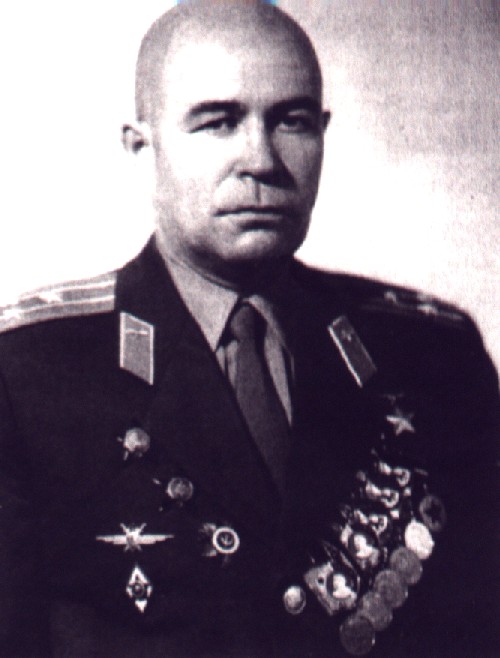
Pepelyayev in 1955, proudly wearing all his decorations, including the Golden Star to the Hero of the Soviet Union.
Besides his impressive record as fighter pilot, his charisma as leader shouldn’t be underestimated. He knew how to motivate his men, obtaining the top of his capacities, but also facing the Top Brass when it dictated stupid rules of engagement that expose his pilots to an unneccesary risk. His unit claimed 108 aerial victories during 10 months (38 of them perfectly match with admitted US aircraft losses), losing only 11 MiGs in action and suffering the lost of 4 pilots killed in action. Excluding him, another seven pilots of the 196th IAP were credited with ace status: Fiodor A. Shebanov (6 victories), Boris S. Abakumov (5), Boris V. Bokach (6), Vladimir I. Alfeyev (7), A.M.Kochegarov (5), Nikolay K. Shelomonov (5) and Lev N. Ivanov (7).
After Korea
When he returned to the Soviet Union, Pepelyayev was promoted to deputy commander of the 15th GvIAD in November 1952, and served in the area of Orel. In early 1953 also took charge of the training of 12 pilots of the 78th IAK that would be sent to fly combat missions in Korea. In 1954 Pepelyayev acted as test pilot of the most recent Soviet combat aircraft, like the MiG-17PF and the Yak-25.
In October 1956 Polkovnik Pepelyayev went to the VVS Staff Academy in Moskow, and he got his degree in November 1958. Then he became the CO of the 133rd IAD of the 56th IAK in the Moskow area (at that time the unit was equipped to MiG-17F/PFs and MiG-19Ps, which were replaced in 1959 by MiG-19PML armed with air-to-air missiles). In May 1960 the 133rd IAD was disbanded, and Pepelyayev took command of the 7th IAK of the 52nd Air Army, which was receiving the brand new jet fighter Sukhoi Su-9. A natural flier, Pepelyayev began to test the Su-9 in person. However, his career as test pilot came suddenly to an end in 1961, when during a routine flight he performed a too tight manuever and suffered a brain hemorrage. Despite he received immediate medical attention and recovered fast of this event, he was considered unsuitable for flying and was assigned to pasive tasks in the HQ of Moskow air defence until 1973, when he retired of active duty.
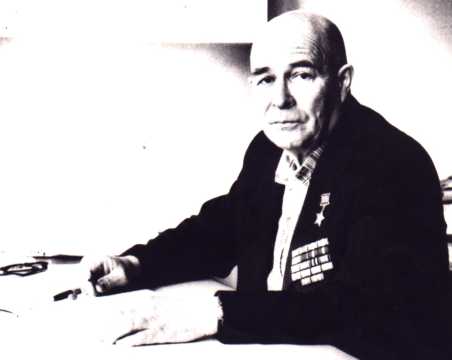
Photo of Yevgeny Pepelyayev taken in 1985, when he was the Main Engineer of the Scientist Research Automatic Instruments Institute in Moscow.
During the next 12 years, Pepelyayev was the Main Engineer of the Scientist Research Automatic Instruments Institute of Moscow, until his definitive retirement in 1985. In July 1993 he returned to North Korea together with two other MiG-15 aces and Heroes of the Soviet Union, Sergey Kramarenko and Dmitriy Oskin, during the commemoration of the 40th anniversary of the end of the war. During the 25 days that lasted the visit, he and his two comrades were treated like heroes by the North Korean population, and all three were awarded by the North Korean ruler, Kim Il Sen.
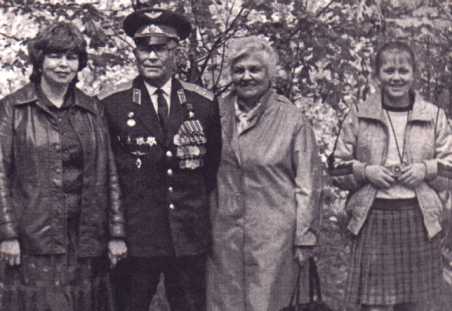
Pepelyayev and his family in the Dyen Pabyedi (Victory's Day - the celebration for the victory against Germany in the WW2) on May 9 1990. From left to right: his daughter Yelena, his wife Maya and his grand-daughter Maya Nikolaievna.
In 1995, when the West began to finally know about the involvement of Soviet MiG-15 pilots in the Korean War, he was invited to visit Maxwell AFB in Alabama, and he was included in the Hall of Fame of the base, together with Francis Gabreski, John Bolt, the German WW2 ace Alfred Grislawski and the Korean War ace Robbie Risner (Sadly, Peplyayev and Risner shared a non-polite conversation during the meeting).
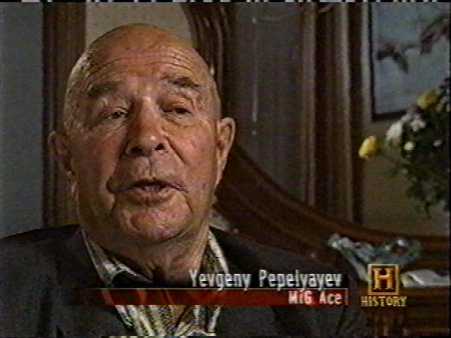
Yevgeny
Pepelyayev, as seen
in the Episode "MiG-15" of the "Battlestations" series,
broadcasted by the History Channel in early 2004. He was 86 years old.
In 2000 the Russian editorial NPP Delta published his autobiography, "MiGi protiv Seibrov" ("MiGs versus Sabres") and in early 2004 he was interviewed by the staff of the History Channel during an episode of the serie "Battlestations" devoted to the MiG-15. During this interview, when he was asked about the key of his success as fighter pilot, he answered:
Col. Yevgeny G. Pepelyayev: "During an air combat, which last, let's say, 20 minutes, you look for a moment of hesitation in your adversary. It is only one or two seconds, but if you are there, it is all that you need, and you win the battle."
During a recent interview in Russia (where he is today a celebrity) a journalist asked his oppinion about the Korean War, he answered:
Col. Yevgeny G. Pepelyayev: "For us, Korea was both a love and an anguish. Back in the 50s we were defending North Korea, and we learned to care for the people. We also felt love for the Chinese people, on whose land our regiments were stationed. But I lost friends there. Soviet pilots lie in the Russian cemetery at Port Arthur. I still remember those sorrowful moments when they buried my fellow servicemen, excellent pilots, my wingman Sasha Ryzhkov, Fedya Shebanov,...."
Sources:
- The 4th Fighter Wing in the Korean War, by Larry Davis, Schiffer Publishing Ltd, 2001.
- MiG Alley: Sabres Vs. MiGs Over Korea, D. McLaren & W. Thompson, Specialty Press, 2002.
- Red Wings over the Yalu: China, the Soviet Union, and the Air War in Korea by Dr. Xiaoming Zhang & Joseph G. Dawson. Texas a & M University Military History Series, 2002 ( courtesy of my Japanese friend Naoaki Ooishi).
- Crimson Sky, by John R. Bruning, Brassey's Inc; 1999.
- Sabre jets over Korea: A first hand account, by Douglas K. Evans, Tab Books 1984.
- US Post World War 2 Victory Credits, Frank Olynyk, 1999 (courtesy of Thomas Polak).
- Krasnij Dyabolij ha 38-u Paralely (Red Devils over the 38th Parallel), Igor Seidov and Askold German (courtesy of Nikolai Bakalov and Rubén Urribarres), 1998.
- MiGi protiv Seibrov, Yevgeny Pepelyayev, Delta NPP, 2000 (courtesy of Thomas Polak).

